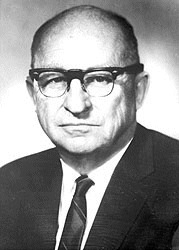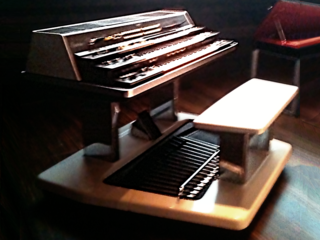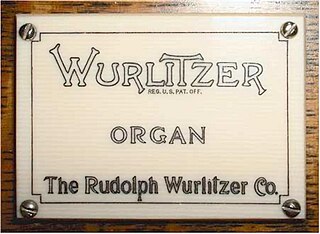Related Research Articles

In music, the organ is a keyboard instrument of one or more pipe divisions or other means for producing tones. The organs have usually two or three, up to five, manuals for playing with the hands and a pedalboard for playing with the feet. With the use of registers, several groups of pipes can be connected to one manual.

Related article: List of surviving Link Trainers

Edwin Albert Link was an American inventor, entrepreneur and pioneer in aviation, underwater archaeology, and submersibles. He invented the flight simulator, which was called the "Blue Box" or "Link Trainer". It was commercialized in 1929, starting a now multibillion-dollar industry. In total, he obtained more than 27 patents for aeronautics, navigation and oceanographic equipment.

An electric organ, also known as electronic organ, is an electronic keyboard instrument which was derived from the harmonium, pipe organ and theatre organ. Originally designed to imitate their sound, or orchestral sounds, it has since developed into several types of instruments:

A theatre organ is a type of pipe organ developed to accompany silent films, from the 1900s to the 1920s.

The Rudolph Wurlitzer Company, usually referred to as simply Wurlitzer, is an American company started in Cincinnati in 1853 by German immigrant (Franz) Rudolph Wurlitzer. The company initially imported stringed, woodwind and brass instruments from Germany for resale in the United States. Wurlitzer enjoyed initial success, largely due to defense contracts to provide musical instruments to the U.S. military. In 1880, the company began manufacturing pianos and eventually relocated to North Tonawanda, New York. It quickly expanded to make band organs, orchestrions, player pianos and pipe or theatre organs popular in theatres during the days of silent movies.

Orchestrion is a generic name for a machine that plays music and is designed to sound like an orchestra or band. Orchestrions may be operated by means of a large pinned cylinder or by a music roll and less commonly book music. The sound is usually produced by pipes, though they will be voiced differently from those found in a pipe organ, as well as percussion instruments. Many orchestrions contain a piano as well. At the Musical Museum in Brentford, examples may be seen and heard of several of the instrument types described below.

M. Welte & Sons, Freiburg and New York was a manufacturer of orchestrions, organs and reproducing pianos, established in Vöhrenbach by Michael Welte (1807–1880) in 1832.
Kimball International, Inc. is an American company which consists of furniture brands: Kimball, National, Interwoven, Etc., David Edward, D'Style and Kimball Hospitality. It is the successor to W.W. Kimball and Company, the world's largest piano and organ manufacturer at certain times in the 19th and 20th centuries.
Seeburg was an American design and manufacturing company of automated musical equipment, such as orchestrions, jukeboxes, and vending equipment. Before it began manufacturing its signature suite of jukebox products, Seeburg was considered to be one of the "big four" of the top coin-operated phonograph companies alongside AMI, Wurlitzer, and Rock-Ola. At the height of jukebox popularity, Seeburg machines were synonymous with the technology and a major quotidian brand of American teenage life. The company went out of business after being sold to Stern Electronics in 1982.
A mechanical organ is an organ that is self-playing, rather than played by a musician. For example, the barrel organ is activated either by a person turning a crank, or by clockwork driven by weights or springs.

The Estey Organ Company was an organ manufacturer based in Brattleboro, Vermont, founded in 1852 by Jacob Estey. At its peak, the company was one of the world's largest organ manufacturers, employed about 700 people, and sold its high-quality items as far away as Africa, Great Britain, Australia, and New Zealand. Estey built around 500,000 to 520,000 pump organs between 1846 and 1955. Estey also produced pianos, made at the Estey Piano Company Factory in New York City.
Gavioli & Cie were a Franco–Italian organ builder company that manufactured fairground organs in both Italy and later France.

The Virginia Theatre is a live performance and movie theatre in downtown Champaign, Illinois. It has been providing theatrical and cinematic entertainment to the Champaign-Urbana community since its doors opened in 1921. Each year, the Virginia Theatre is host to movies from film reels, plays from various acting troupes, concerts, and Ebertfest, presented by the UIUC College of Media. It is currently owned by the Champaign Park District.
The Automatic Musical Instruments Collectors' Association (AMICA) was formed in 1963 by a group of collectors in the San Francisco area, committed to the preservation, restoration and enjoyment of vintage mechanical musical instruments that play by themselves, focusing on those made from 1885–1935. Typical examples include player pianos, reproducing pianos, player reed organs, player pipe organs, orchestrions, music boxes, fairground organs, etc. Music media includes paper music rolls, folding continuous cardboard music, pinned cylinders, and pinned discs, etc. The scope of interest embraces not only the instruments themselves, but also their music media and published literature of the whole of the industry throughout this era.

The American Fotoplayer is a type of photoplayer developed by the American Photo Player Co. between the years of 1912 and 1925. The Fotoplayer is a type of player piano specifically developed to provide music and sound effects for silent movies.

The Musical Museum is a charity, museum and concert venue located in Brentford, London Borough of Hounslow, a few minutes' walk from Kew Bridge railway station. Its stated purpose is to conserve, preserve, and develop nationally important collections related to the history of music reproduction; inform, engage and entertain the public regarding the evolution of music reproduction; and conserve, preserve, promote and present the theatre pipe organ as an instrument with a significant role in the development of light music on radio and in the cinema and as a musical art form.
William Hill & Son & Norman & Beard Limited were a major pipe organ manufacturer originally based in Norfolk.

Edwin Scott Votey was an American businessman, inventor, industrial designer, and manufacturer of pianos and organs. He worked in the organ field all his adult life and had over twenty patents. He invented or co-invented several inventions for World War I. One was a pilotless airplane that was going to be used to drop bombs on the enemy but was never used.

The American Treasure Tour is a tourist attraction established in 2010 and opened to the public for guided tours. Visitors travel through a large private collection that encompasses an eclectic variety of smaller collections. Included is one of the world's largest private collections of automatic music machines: nickelodeons, band organs, calliopes, photoplayers, and music boxes. There are also classic cars, circus art, dolls and dollhouses, and a large assortment of popular culture miscellanea. It is located in the 422 Business Center in the community of Oaks, Pennsylvania, west of Valley Forge National Historical Park just off of U.S. Route 422.
References
- 1 2 3 "Theatreorgans.com". Archived from the original on 7 March 2014. Retrieved 7 March 2014.
- ↑ "Automatic Musical and Link Piano and Organ Company" . Retrieved 7 March 2014.
- ↑ "The Link Flight Trainer". ASME International. 10 June 2000. Archived from the original on 26 March 2015. Retrieved 5 May 2017.
